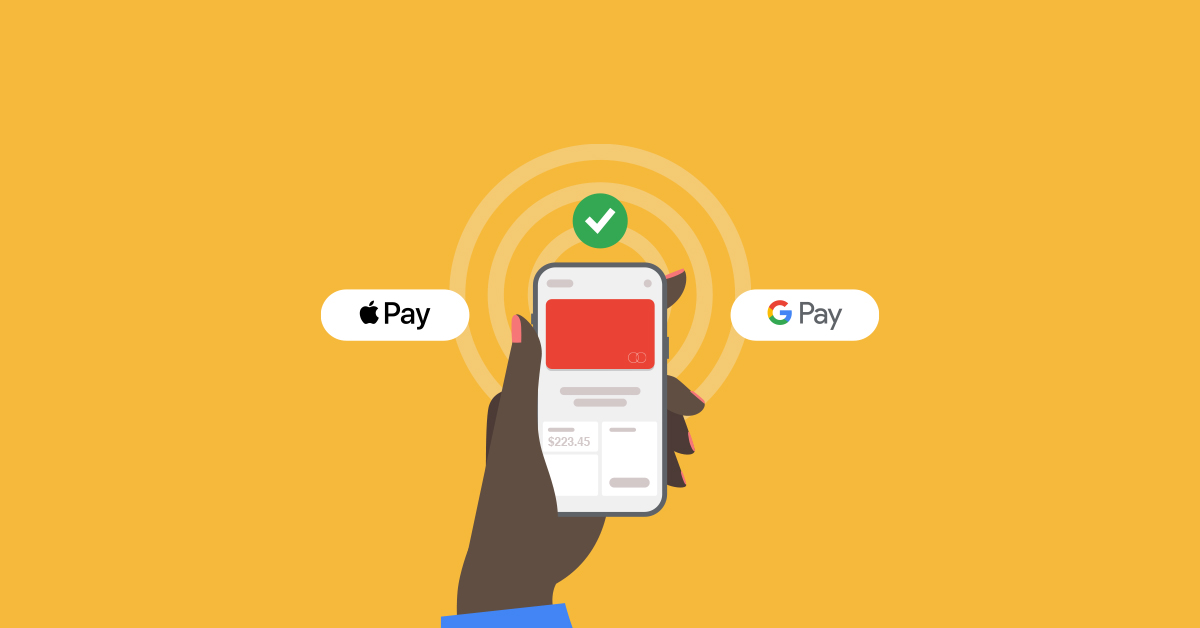
From the grocery store to their everyday commute, customers across the US are opting for contactless payments as their preferred payment method.
More than half of American shoppers now use contactless payments, according to a recent Mastercard survey.
Payment methods and consumer expectations are constantly changing, and retailers need to adapt to stay competitive. In this article, we’ll answer common questions about contactless payments. By the end, you’ll understand why your business should offer contactless payment options.
Here’s what we’ll cover:
- What are contactless payments?
- What are some examples of contactless payments?
- Why should you accept them?
- How do you get started?
- How do you choose the right processor?
Learn how to choose the best credit card processor
Wasting time on the wrong processor can literally cost you. Avoid this mistake and others with our free, easy-to-follow guide.
1. What are contactless payments?
Contactless payments are wireless financial transactions, where your customer approves their purchase by hovering their device near your point of sale (POS) reader of the vendor. Customers don’t need to touch the retail POS system or insert a physical card into your reader.
Contactless payments use near-field communication (NFC) technology. It enables two devices to communicate at a very short distance. This technology initiates a transaction between the two devices.
Tap to pay on credit and debit cards uses radio-frequency identification, or RFID, technology. When a card is hovered above a terminal, the POS captures short-range radio frequencies with the card’s information to initiate and process the transaction.
2. What are some examples of contactless payments?
You’re probably already familiar with some of these contactless payment methods:
- Apple Pay: Apple’s payment service helps shoppers make purchases using their iPhone, iPad, Apple Watch or Mac via Safari.
- Google Pay: Google’s payment service allows people to make purchases using their Android phones, as well as Google’s Chrome web browser.
- Samsung Pay: Samsung owners can swipe up on supported devices to launch Samsung Pay and tap their phones against the payment terminal. Samsung Pay supports magnetic strip terminals too, making it compatible with virtually every standard credit card reader.
- Credit and debit tap: Most credit and debit cards now have tap technology. Customers tap or hover their cards over the payment terminal to pay. Rather than insert or swipe their card and enter their PIN, they can simply tap and go.
With these contactless payment methods, you can pass data from one device or card to a payment terminal over radio waves, once both devices are close enough to each other.
3. Why should my store accept contactless payments?
That’s one of the payment processing questions we get asked a lot. The short answer is that they are getting more popular than ever. There’s plenty of data to back this up.
In 2022 alone, the global contactless payments market was valued at over $22 billion. Plus, 38% of Americans prefer contactless payment methods when shopping at retail stores.
Gen Z consumers are three times more likely than older generations to use alternative payment methods, including contactless. They also have certain expectations when it comes to payment experience: in one survey, 39% considered entering a PIN to be a pain point when using a debit card, versus 29% of other generations.
Visa also reported that one out of every 10 Visa card transactions in the US are conducted with tap.
But there are more reasons than just popularity for retailers to begin accepting contactless payments.
They are fast
Contactless payments take seconds to process and are as simple as a tap, said Patrick Brown, the owner of Personal Shop, a UK-based gift store. “In high-volume stores this means fewer employees are required at the [checkout counter]. Customers expect speedy service and don’t want to wait in line to pay,” he said. Contactless payments are a useful way to meet these needs.
Contactless payments take seconds to process and are as simple as a tap, said Patrick Brown, the owner of Personal Shop, a UK-based gift store. “In high-volume stores this means fewer employees are required at the [checkout counter]. Customers expect speedy service and don’t want to wait in line to pay,” he said. Contactless payments are a useful way to meet these needs.
So how can speedy contactless payments make your business better?
Reduced checkout times: First, you can serve more customers in less time with reduced checkout times. Not only will shoppers leave more satisfied, but you’ll shave time off checkout during peak hours.
Improved customer experience: Shorter lines and wait times means happier customers, which could increase loyalty and visits.
Increase transaction volume: The faster your payments, the more transactions you can process. With contactless payments, your sales potential increases.
Boosted employee efficiency: Your employees will benefit from spending less time handling payments, allowing them to focus on other tasks.
They are private
With contactless payments, the customer does not share billing or payment information directly with the retail employee at the POS. Retail staff never “see” the card. Instead, all communication is encrypted and tokenized, and each purchase is assigned a different transaction number.
Because sensitive card information isn’t exposed during transactions, your customers can feel reassured that their data is protected. Your business will also face a lower risk of data breaches.
They are secure
Fraudsters have a hard time with contactless payments too, explains Andrew Dale
Technical Director at CloudTech24. “Near-field communication (NFC) technology protects payments from fraudsters who are standing at a distance attempting to steal data because of its close proximity. NFC contactless payments can only be made when the payment devices are within a few millimeters of each other,” he said.
They are hygienic
They’re a better fit for the post-COVID era too.
“Customers never have to touch the machine or the PIN pad when making contactless purchases,” said Andreas Velling, CMO of Fractory, an online metal fabrication company. “Instead, they only make touch with their card or phone, isolating any germs and reducing the risk of spreading to the next consumer.”
They may lift order values
While contactless payments are quicker and safer, they may have another nice knock-on effect too. Some researchers have suggested they can lift order values and indeed several studies over the years have shown shoppers tend to spend more when they avoid using cash. The speed and convenience of tap-to-pay mean they can be a real driver of impulse buys, which opens up a range of possibilities for checkout merchandising and promotion.
Shoppers and tourists want contactless
Above all, customers value contactless payments. “Retailers who accept contactless payments provide a faster and smoother checkout experience, earning the loyalty of their customers,” according to Tyler Martin, a certified business coach and the founder of ThinkTyler. International tourists from countries like the UK, Ireland and Australia see tap-to-pay as the norm too.
4. How can retailers get started with contactless payments?
Retailers looking to expand to contactless payments need to get the business a POS terminal that includes NFC technology. The good news is that you might already have everything you need, if you made the move to an EMV-ready device a few years ago. Many EMV-ready devices also offer NFC capabilities.
Countertop POS terminals
When purchasing a POS terminal or software, be sure to ask if the proper hardware is preinstalled to accept contactless payments.
“Any terminal that accepts contactless cards can also accept alternative contactless payments like mobile wallets, watches, and other wearables,” said Michael Hess, eCommerce Strategy Lead at CodeSigningStore, which provides code signing certificates for business websites.
“Take the procedures to enable contactless EMV chip capabilities if you’re considering a migration to EMV chip technology. Accepting contactless payments shows that you’re up to speed on payment technologies as a retailer.
To make it easier, consider using a POS system with an embedded payment processor. That way, you’ll always stay up to date with new payment methods, allowing you to readily meet your shoppers’ expectations.
Related: Your definitive guide to embedded payments.
Mobile POS terminals
The speed and simplicity of contactless payments create some added considerations too. Because they are mobile in the truest sense of the word. Customers can pay you wherever they are in the store, which means your POS can now effectively be everywhere, not just at the cash wrap of your store, like it was a decade ago.
For this reason, handheld POS terminals can be a good choice.
Tip: If you have a system that supports NFC technology, you can support almost any contactless payment method — such as Apple Pay, Android Pay or Samsung Pay.
Related: Here are 10 things to look for when you’re purchasing a POS system.
5. How should I assess contactless payment processors?
But like almost everything these days, there are many options. Here are some guardrails to help you narrow down your options, when it comes to choosing a payment processor to help you implement tap-to-pay. Vet potential vendors on these criteria.
- Customer support: Technology breaks and the fix isn’t always simple. Choose a payments hardware and software provider with excellent support and resources available to help you learn their systems and resolve any issues that may arise.
- Software and app integrations: There are also factors to think about that go beyond just your ability to accept payments. If you’re considering a commerce platform with integrated processing, make sure it can connect with your other day-to-day tools, whether that’s your accounting software or payroll program. Relevant integrations will save you time managing the business’s finances, taxes and HR.
- Omnichannel capabilities: If you’re going with a commerce platform, it should support an omnichannel strategy, connecting your online store to your retail shop. A commerce platform safeguards stock by syncing products, transactions and other data across sales channels, keeping your inventory and financials organized. To execute this strategy, you’ll want a payment processor that can support both in-store and online transactions like a payment gateway.
- Reporting and analysis: Data is a key part of discovering business trends and seasonal products. By being able to gain insight into your retail business you can track what is contributing to your success, view revenue reports and see other key retail metrics. With the right data, you can drive more sales and tap into new revenue streams.
The importance of contactless payments: a case study
Women’s apparel boutique The White Orchid combines tradition with the latest trends. Over the years, founder Diane Muno found their old system wasn’t allowing them to meet quickly evolving customer needs.
She highlighted the growing need for modern payment systems. “They want to be able to pay with their phone, with their watch and every way that suits them. They’re surprised if they have to pay through an old fashioned method.”
So Diane made the switch to Lightspeed Retail and Lightspeed Payments, which is flexible, fast and offers a variety of payment methods. Now, Diane’s customers can pay through tap, their phone, card and more.
With their new system, Diane and her employees have more free time and can work efficiently.
Drive sales with contactless payments
The retail world is constantly evolving and a cloud-based solution will ensure you can manage your business anywhere that works for you.
Need a payment processor that can support in-store, contactless and online payments? Talk to an expert to learn more about Lightspeed Payments.

News you care about. Tips you can use.
Everything your business needs to grow, delivered straight to your inbox.



